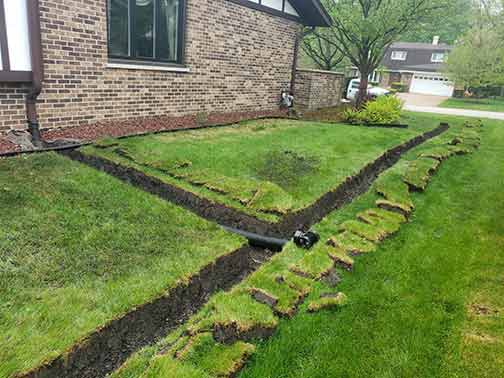
Dealing with drainage problems can be an uphill task, especially for property owners who are inexperienced in solving such problems. One of the most effective solutions for dealing with drainage problems is installing a French Drain. French drains are popular because they are reliable, efficient, and easy to install. This guide outlines everything you need to know about French drains, how they work, and how they can solve your drainage problems.
What is a French Drain?
A French drain is a trench filled with gravel or rock that is designed to redirect water away from a property. It is usually dug at a shallow depth and sloped away from the property to allow water to flow naturally. The trench is lined with landscape fabric, which prevents soil and debris from clogging the drain. The gravel or rock provides a permeable channel through which water can flow.
How do French Drains work?
French drains work on the principle of gravity. When water accumulates on the surface, it flows naturally to the lowest point, which is usually the French Drain. The water flows through the gravel or rock into the drain, where it is redirected away from the property. French drains can also be connected to downspouts, gutters, or other drainage systems to enhance their efficiency.
When should you install a French Drain?
You should install a French Drain when you notice any of the following signs of poor drainage:
- Stagnant water on the surface.
- Muddy soil.
- Waterlogged plants.
- Foul odor near water sources.
- Water damage in the basement or crawl space.
Steps to installing a French Drain
Installing a French drain requires some skill and knowledge. However, with the right tools and guidance, you can do it yourself. Here are the steps to follow: Determine the location of the French drain: Identify the lowest point on your property and mark it. This is where you will install the French drain.
- Dig the trench: Dig a trench from the lowest point to a suitable outlet for the water. The trench should be at least 12 inches deep and 12 inches wide. Ensure that it has a slight slope away from the property.
- Lay the landscape fabric: Line the trench with landscape fabric to prevent clogging by soil and debris.
- Fill the trench with gravel or rock: Fill the trench with gravel or rock up to 2 inches below the surface. Compact the material to ensure it is stable and level.
- Cover with soil: Cover the drain with soil and sod to conceal it completely.

Installing a French drain requires some skill and knowledge. However, with the right tools and guidance, you can do it yourself.
Types of French Drains
There are four main types of French Drains:
- Standard French Drain: This drain is the simplest design and consists of a gravel-filled trench covered with landscape fabric. It is commonly used for surface water drainage.
- Perforated Pipe French Drain: This type of French drain includes a perforated PVC pipe surrounded by gravel or rock. It is used for subsurface drainage and is effective for intercepting and diverting water before it reaches the surface.
- Gravel-free French Drain: This type of French drain consists of a single-walled corrugated pipe surrounded by polystyrene aggregate or stone. It is an alternative to traditional French drains that require gravel or rock. It is lightweight and easy to transport, making it suitable for low-lying areas and large commercial properties.
- Curtain French Drain: This type of French drain is used to intercept and divert water from hillsides and slopes. It consists of a series of trenches filled with gravel and connected to a perforated pipe. It helps to stabilize the slopes and prevent erosion.
Maintenance of French Drains
Maintaining your French drain is essential to ensure its effectiveness over time. Here are some maintenance tips:
- Remove debris from the surface drain regularly to prevent clogging.
- Inspect the underground pipes for blockages or damage periodically.
- Trim roots and remove any vegetation that may grow into the drain.
- Check the slope of the trench regularly to ensure proper drainage.
Conclusion
If you are experiencing drainage problems on your property, a French drain is an excellent solution. It is cost-effective, efficient, and easy to install. By following the steps outlined in this guide, you can install a French Drain yourself and enjoy a dry and healthy property. Remember to choose the right type of French drain for your specific needs, and maintain it to ensure its optimal performance.